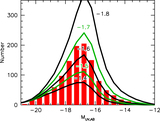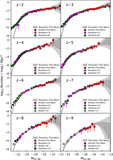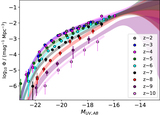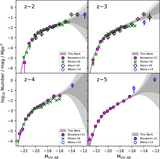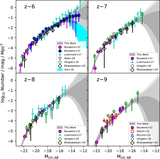Image Details

Caption: Figure 1.
Upper panel: the number of sources per unit redshift (shown in logarithmic units) in our lensed sample constructed from the HFF “cluster” fields (light-red histogram) and this sample combined with the Bouwens et al. (2021a) blank-field sample (black histogram). Middle panel: the distribution of sources in apparent magnitude and redshift from our HFF “cluster” fields (red circles; Bouwens et al. 2022b) and from an HST blank-field sample with >24,000 sources (blue circles; Bouwens et al. 2021a). Lower panel: the distribution of sources in UV luminosity and redshift from our HFF “cluster” fields (red circles) and from an HST blank-field sample (blue circles). It is clear that selections using lensing magnification can reach up to ∼10–40× fainter in luminosity than achieved using similar selections without the aide of lensing magnification. The relative paucity of z ∼ 4–5 sources in our HFF “cluster field” selections relative to blank-field selections is a direct result of the very conservative selection criteria we impose at those two redshifts to minimize contamination from galaxies in the foreground clusters (see Figure 3 from Bouwens et al. 2022b).
Copyright and Terms & Conditions
© 2022. The Author(s). Published by the American Astronomical Society.


